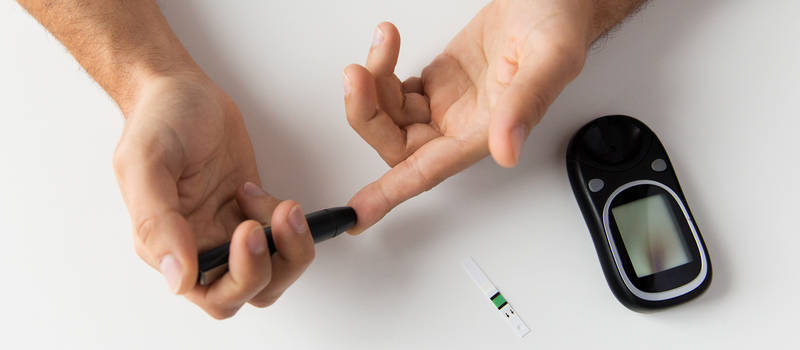Type 2 diabetes, formally known as diabetes mellitus type 2, is a chronic condition of the pancreas where the body can’t create enough insulin on its own.
Type 2 accounts for more than 90% of all cases of diabetes in America. Because of the long term health concerns, finding life insurance for type 2 diabetics can be a pretty big hurdle.
Life Insurance For Type 2 Diabetics: A Guide To Securing Coverage
 There is no cure for diabetes. Even with a perfect treatment regimen, over time the body will suffer more and more. As it relates to your longevity, it can impact your overall life expectancy, so life insurance carriers are forced to increase their rates accordingly.
There is no cure for diabetes. Even with a perfect treatment regimen, over time the body will suffer more and more. As it relates to your longevity, it can impact your overall life expectancy, so life insurance carriers are forced to increase their rates accordingly.
Life insurance for diabetics can as much as 5x more than a person without diabetes, though type 2 diabetics see much better rates than type 1.
A case of a well controlled applicant can actually be relatively easy, assuming they are following a strict diet, exercise plan, and have a long consistent history. Even with prescription use, type 2 diabetics could be approved at discounted rates.
But for those with minor to more drastic complications, prices can jump very quickly.
For this reason, we always suggest a person secure some type of coverage now as opposed to later. Not only could each medical condition increase your rates, they may even affect your ability to be approved.
Getting Started: What You Need To Know
Having a medical condition like type 2 diabetes can make the already confusing process of shopping for life insurance even more daunting. But there are ways to increase your chances of finding a good policy, and it all starts with learning more about the process.
Around 29 million Americans have diabetes, the vast majority of whom have type 2 diabetes. For these patients, issues with insulin resistance not only can cause serious health concerns, but they can also lead to difficulties with insurance.
Finding a life insurance policy is a common problem for people with a chronic condition, something that is true for these millions of diabetes patients.
But with some preparation and information, you can increase your chances of finding a life insurance policy which fits the needs of you and your family.
The Basics of Type 2 Diabetes (And Why It Impacts Insurance)
Sometimes called adult-onset diabetes, type 2 diabetes is typically diagnosed during middle to late adulthood.
In this form of the condition, the body either becomes resistant to the hormone insulin or fails to produce enough of the hormone.
Insulin helps the body regulate the metabolism of sugar and its movement into the body’s cells. When insulin isn’t used, made, or responded to correctly, blood glucose (or blood sugar) levels rise.
Initially, this insulin resistance can cause symptoms like hunger, thirst, fatigue, and weakened vision.
Over time, it can lead to more serious complications, including:
- major damage to the kidneys
- difficulty with the eyes
- harm to the nerves
- complications in the feet or extremities
- an increased risk of heart problems like stroke and heart attack.
It is because of this possibility of serious complications which makes finding life insurance a struggle for patients with type 2 diabetes.
But, these potential complications do not mean it is impossible to find life insurance! It just means type 2 diabetics need to be prepared and informed.
And, the good news for type 2 diabetes is a condition which is typically manageable.
With steps like regular doctor’s visits, diet, and exercise, blood sugar levels can be kept in check, and diabetes patients can stay healthy.
Proper condition management means good things not only for a patient’s long term health and wellness, but it also means good things for their search for a life insurance plan.
For people with type 2 diabetes, most can expect premium rates on par with rates found by patients with other long term, but manageable chronic conditions.
These premium rates are typically higher than the rates found by those with no health conditions at all, but are lower than patients with conditions deemed more serious by insurance companies. These more serious conditions often include type 1 diabetes.
This is because patients with type 1 diabetes (usually diagnosed during childhood) must live with and manage the disease for many more years than the average type 2 patient, and the condition is seen as a more serious risk to insure, overall.
The bottom line is, despite the fears of many type 2 diabetes patients, there are life insurance plans available to them, and they should be able to find options at a fairly reasonable price.
Finding a good plan may be especially easy for patients who take proactive steps to manage their condition, and use this proactivity to their advantage when shopping for insurance.
Using Good Disease Management to Improve Life Insurance Options
When applying for life insurance plans, applicants are required to supply the insurance companies with a host of information about themselves, their health, and their medical history.
As a part of this process, you can expect to provide medical documents, answer questionnaires, and undergo a medical exam. The exam will involve providing samples, both in the form of blood and urine samples.
The goal of all of this information gathering is for the insurance company to be able to properly assess the risk of insuring you. They use this information to decide to accept or decline your application for coverage, and to decide what rates you qualify for if you are approved.
While the information provided may seem overwhelming, it will actually prove to be beneficial for many type 2 diabetes patients.
Without this background information, insurance companies may otherwise simply see a chronic condition, like diabetes, and either deny your application outright, or postpone you.
But, if your condition is well managed and you have a history of good health, you are likely to get approved and avoid high fees.
These detailed physical exams and medical histories help reflect your actual health status to insurance companies and provide a lot more detail than simply the name of your condition.
Pro Tip: The day you complete your exam, call your doctor and let him know you’ve applied for coverage. It will greatly speed up the process for them to send your medical records for the underwriter’s review!
For example, a type 2 diabetic who is overweight, doesn’t have a great track record of visiting their physician, and has regularly high measures of blood sugar levels is likely to face a higher rate than a patient who has maintained a healthy weight, visits their physicians regularly, and has managed to keep their blood sugar levels under control.
So, if you are a type 2 diabetic who is shopping for life insurance, or even if you think you might like to purchase a plan at some point within the next few years, it is wise to consider some factors which might improve your chances of getting a good deal.
Consider Your Levels and Metrics
Keep regular tabs on your blood sugar levels and the state of your diabetes through daily measurements, and discussions with your doctor.
An A1C test analyzed in a laboratory reveals your average blood sugar over the past several months and is helpful for revealing trends and providing insight into your long term health.
Fact: Your A1C is a key marker when you buy life insurance. This number alone can greatly affect your rates!
You should also keep a daily log of the blood glucose measurements you obtain at home. These logs help provide more detailed, day-to-day data, as well as suggest to the insurance company you are proactive in managing your condition.
You should also have your urine regularly analyzed, as this can be a good way to spot a common diabetes complications, like kidney damage. And regular checks of your blood pressure, as well, can help you make sure your cardiovascular system is staying healthy.
As you apply for a life insurance plan, these measurements are likely to be requested, anyway. Staying on top of them is not only crucial for your health, but it’s also a helpful way to improve your likelihood of getting approved.
Engage with Your Doctor Frequently
Another great way to improve your life insurance outcome is to show a solid and stable history of regular visits with your doctor.
Health professionals typically recommend patients with type 2 diabetes see their doctor once every three to six months.
Be sure to either visit an endocrinologist, who specializes in diabetes, or a general physician with plenty of experience dealing with diabetes.
You should also keep up with regular visits to the eye doctor, as vision issues can be a complication of the condition. Generally speaking, a yearly visit that includes a dilated eye exam is sufficient.
This patient-doctor engagement shows you are proactive and hands-on when it comes to managing your diabetes.
It is always preferable to prevent complications rather than just treat them.
This is not only true for your health, but it is also true from a business perspective for your potential life insurers. They’ll see your history of regular visits and a proactive role in your health as indicative of a lower risk of complications down the line.
Manage Your Medication
Another aspect which signals good disease management is staying up-to-date with all prescribed medications.
As a part of your life insurance application, you’ll have to provide details on all medications prescribed to you.
By taking these medications as prescribed, for as long your doctor prescribes them, you can again signal a dedication to staying on top of your health. Patients who take their medication as prescribed are more likely to have better health outcomes, so insurance companies will take note.
Another thing to keep is mind is a stable prescription is better than varying. If you are constantly making adjustments up and down, it show less stability and greater risk.
Stay Fit and Healthy with Diet and Exercise
It is also in your best interest to stay fit and active.
When considering your life insurance application, companies will undoubtedly examine your Body Mass Index, or BMI. This measurement is a ratio of weight to height and is used to determine whether someone is underweight, overweight, or in a healthy weight range.
Your activity level is another common subject which will likely come up in questionnaires and medical histories.
If you lead an active lifestyle, avoid obesity, and maintain a healthy BMI, you are likely to stay healthy longer and receive better life insurance options.
Eating a healthy diet plays a significant role in staying fit, too.
Eating properly will not only help you control your blood glucose levels, but it will also help you maintain a healthy body weight and ward off complications, like cardiovascular troubles.
If you need to lose weight, be sure to do it in a healthy way. Rushing into extreme weight loss can be very dangerous for your body. Plus, extreme weight loss is less likely to stick and make a long-term impact for the better on your health.
Find activities you enjoy, eat healthfully, and stay active. Your body will be healthier for it, and your life insurance policy might be more affordable for it, too!
Stop Smoking!
Being a smoker hurts everyone applying for life insurance, not just diabetics.
But since people with type 2 diabetes are likely already facing higher base rates, it is wise to make every effort they can to affect those parts of their health they can control, including their smoking status.
Diabetics who smoke are greatly impacting their ability to get approved, not just being approved with higher premiums.
Smoking is bad for your health to begin with, and its dangerous effects can become even more so in someone who is already at risk for other complications like heart problems or nerve damage.
Try to kick the habit and stick with it. Consider making documentation of your efforts, and remember there are a wealth of resources online if you are having trouble quitting.
Fact: The minimum amount of time a life insurance company needs for you to be considered a non-smoker is at least 1 year of no tobacco use, but up to 2 year.
Gather the Relevant Documents
Before you apply, take the time to locate and organize all relevant documents related to your health history, particularly your history with diabetes.
Your application prep might involve calling doctors for details and lab reports you can’t find. You may also need to seek out family medical history details.
As much as possible, prepare and organize this information beforehand. It can help you get an idea of the overall health picture you are providing to life insurers, which might help you identify ways you can improve or positively affect your health.
Gathering these documents will also make the application process smoother and simpler, and even faster, which is always a good thing.
And by considering all of the above health factors, integrating them into your lifestyle, managing your condition, and being prepared with documentation, you could put yourself in position to receive a more ideal life insurance package.
Life Insurance Options for Type 2 Diabetics
Now that you’ve begun thinking about preparing yourself for life insurance shopping, you might want to think about what kind of plan you will ideally be shipping for.
Many people with type 2 diabetes will find themselves debating between several different types of life insurance policies, including:
- Term life insurance
- Permanent life insurance
- Guaranteed or “no-exam” life insurance
Term life insurance is set to cover certain durations only, like for example, 10 or 20 years. If you die within the protected time frame, your beneficiaries will receive a set amount of funds.
Permanent life insurance, on the other hand, will cover you throughout the course of your life, and the value of these policies typically grow with time.
Term life insurance is generally cheaper than permanent life insurance. And since life insurance of all types is usually higher for people with type 2 diabetes, a term life plan is a common choice for these patients.
Term life insurance is also a common choice for people who only want life insurance coverage for a certain period of time. These people might only need or want coverage until their home is paid off or until all their children are living independently, for example.
However, a permanent life insurance plan does have its benefits for some type 2 diabetes patients, if you can find a plan you qualify for and can afford. The benefit of being covered for the remainder of your life might be especially important if you are worried about leaving your family with medical bills, no matter when you might pass.
You can also shop around for guaranteed or “graded” policies.
These life insurance policies do not require the detailed approval processes and medical exams of other plans. It is far easier to get approved for these plans, but, as might be expected, they are also far more expensive.
No exam plans might not be the best option for everyone, but they are a good option for some type 2 diabetes patients.
For example, if you’ve had trouble keeping blood sugar levels in check throughout the years and have dealt with some severe diabetes complications, a plan which doesn’t require a detailed medical examination might be best for you.
These plans can also be a good choice if you’ve been having trouble getting approved for other plans, since they are much less restrictive to the applicants.
As you shop for life insurance, consider what your goals and needs are, and consider the situation your family will be in if you were to die. Although this line of thought may not be the most pleasant, it is very important to consider, especially if you have family members depending on you.
It is also a great idea to discuss the matter with a knowledgeable insurance agent who knows what options might be available for your unique situation and may be able to provide advice on how you can best meet your needs.
Don’t Get Discouraged
No matter what plan type you decide to shop for, remember to shop around and not be discouraged.
Know that different life insurance companies will take drastically different approaches to type 2 diabetes. Just because one group offers you a very high monthly premium, this won’t necessarily be the norm.
Do your research and consider enlisting a professional, like us, who knows the ins, outs, and preferences of different companies in the industry.
And remember, you can play a significant role in both your health and your life insurance premiums by staying active and engaged with your health care. Visit your doctor frequently, stay on top of your blood sugar management, get active, and eat a healthy diet.
Good disease management won’t just help you find a better life insurance plan to protect your family, it will also help you stay well so that you can better enjoy your time with them!

















